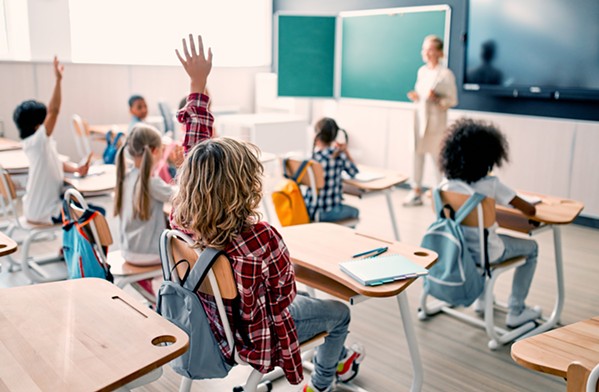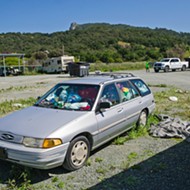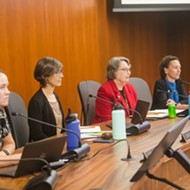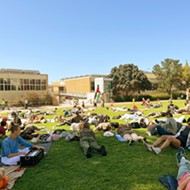School districts struggle to make up the learning loss experienced during the COVID-19 pandemic
By Camillia Lanham[{
"name": "Newsletter Promo",
"id": "NewsletterPromo",
"class": "inlineCenter",
"insertPoint": "4",
"component": "15264767",
"requiredCountToDisplay": "0"
},{
"name": "Ad - Medium Rectangle CC01 - 300x250",
"id": "AdMediumRectangleCC01300x250",
"class": "inlineCenter",
"insertPoint": "8",
"component": "2963441",
"requiredCountToDisplay": "12"
},{
"name": "Ad - Medium Rectangle LC01 - 300x250",
"id": "AdMediumRectangleCC01300x250",
"class": "inlineCenter",
"insertPoint": "18",
"component": "2963441",
"requiredCountToDisplay": "22"
},{
"name": "Ad - Medium Rectangle LC09 - 300x250",
"id": "AdMediumRectangleLC09300x250",
"class": "inlineCenter",
"insertPoint": "28",
"component": "3252660",
"requiredCountToDisplay": "32"
}]
Although students in the San Luis Coastal Unified School District are still behind compared to before the pandemic, the district is positive it's moving in the right direction.
"We're on a path of growth in the single digits," said said the districts's new assistant superintendent of education, Lisa Yamashita. "As a district, we've increased [testing scores] when we first came back from COVID in 2021 to 2023, we're showing progress. But we've yet to match the pre-COVID scores in all schools and all student populations."
Smarter Balanced assessment scores for English language arts (ELA) and math for the 2022-23 school year aren't yet final or public, but Yamashita said the initial numbers show improvement over the 2021-22 school year. The tests are taken by students in grades three through eight and 11.
"Preliminary student performance data suggests that we are moving back to pre-COVID achievement levels," she said. "The past three years have been difficult for students—especially in the areas of attendance and mental health. This, of course, impacts achievement."
According the the California Assessment of Student Performance and Progress, in 2021-22 about 64 percent of San Luis Coastal students tested at or above grade level for ELA, with about 55.6 percent testing at or above grade level for math. Before the pandemic, during the 2018-19 school year, 70 percent of students tested at or above grade level for ELA with 64 percent of students doing the same for math.
San Luis Coastal is faring better than the state, the county, and the majority of other local school districts, but it still has a ways to go before students reach pre-pandemic levels of learning. This is similar to school districts across the nation, all of which are still grappling with the COVID-19 pandemic's impacts on students.
A study released by the Harvard University Center for Education Policy Research in May looked at data from 7,800 communities in 40 states and Washington, D.C. It found that the average U.S. public school student in grades three through eight lost the equivalent of half a year of learning in math and a quarter of a year in reading.
"The educational impacts of the pandemic were not only historically large, but were disproportionately visited on communities with many low-income and minority students," study co-author and Stanford education professor Sean Reardon said in a press release. "Our research shows that schools were far from the only cause of decreased learning—the pandemic affected children through many ways—but they are the institution best suited to remedy the unequal impacts of the pandemic."
Researchers also looked at data from the decade prior to the pandemic to see how students bounced back after learning loss due to disruption in their schooling. Evidence showed that affected students recovered 20 to 30 percent of the lost ground in the first year, but didn't make any further strides in the next three to four years.
Co-author Thomas Kane, the faculty director at Harvard's Center for Education Policy Research, said in the hardest hit communities, schools would need to teach 150 percent of a typical year's worth of material for three years in row to catch students up.
"That is simply not going to happen without a major increase in instructional time," Kane said in the release. "Any district that lost more than a year of learning should be required to revisit their recovery plans and add instructional time—summer school, extended school year, tutoring, etc.—so that students are made whole."
California Superintendent of Public Instruction Tony Thurmond said that the state is working proactively to provide additional resources to help students beyond 2024, when federal relief funding expires. However, it still has a lot to make up. The percentage of California students meeting or exceeding standards on the 2022 Smarter Balanced assessment decreased by 4 percentage points for ELA and 7 percentage points for math when compared to students who took the tests in 2018-19, according to a press release.
"The road to recovery is long and our students will need sustained support over many years," Thurmond said in the release. "The [California Department of Education] will continue to work with schools so they identify the right tools and resources to address academic, behavioral, and mental health needs."
Testing data shows that Shandon Joint Unified School District has the lowest performing students in the county, with only 14.1 percent of students testing at or above grade level for ELA and 8.7 percent for math during the 2021-22 school year. In 2018-19, 32 percent of Shandon students were at grade level for ELA and 25 percent for math.
San Luis Coastal students have higher achievement scores than the majority of the county's school districts, coming in behind students in Cayucos and Pleasant Valley as well as the Bellevue-Santa Fe Charter School, which was the highest performing in the county for 2021-22, with 83.3 percent of students at or above grade level for ELA and 85.7 percent for math.
As the school year begins, San Luis Coastal's Yamashita said the district is focused on academic achievement, safety, and wellness. This includes having full-time counselors at all elementary schools; increased professional development for teachers, school counselors, and support staff; and additional support teachers and instructional aides for reading and math intervention.
"We are, this year, continuing to focus on setting expectations at the beginning of the school year ... being really explicitly clear about expectations of students as they arrive at school," she said. "Because, again, students have missed some learning time, it's important to set those expectations to create a good learning environment where learning can happen."
Yamashita said the increase in support staff and counselors at the schools should help address disruptive behaviors in classrooms and help students with social-emotional learning, so teachers can focus more on teaching than intervention and students can learn how to manage emotions such as anger and free up their brains to focus on learning instead. Over the past two years, she added, student behavior has been a challenge for teachers and students as they rediscover "their executive functioning, relearn appropriate social discourse, and adjust to a regular routine."
"It is just going to take students time to relearn how to act in social settings and classrooms, as opposed to working at home from a computer when there's only one or two people around," she said. "There's very different expectations." Δ
Reach Editor Camillia Lanham at [email protected].
Latest in News
Readers also liked…
-

Coast Unified teachers upset over new position's salary and qualifications
Oct 20, 2022 -

SLO police identify alleged driver who hit and killed couple
Dec 22, 2022 -

When the levee breaks: Oceano residents, county officials walk a tightrope of regulations to manage Arroyo Grande Creek, which some say led to the levee's failure in January
May 18, 2023










